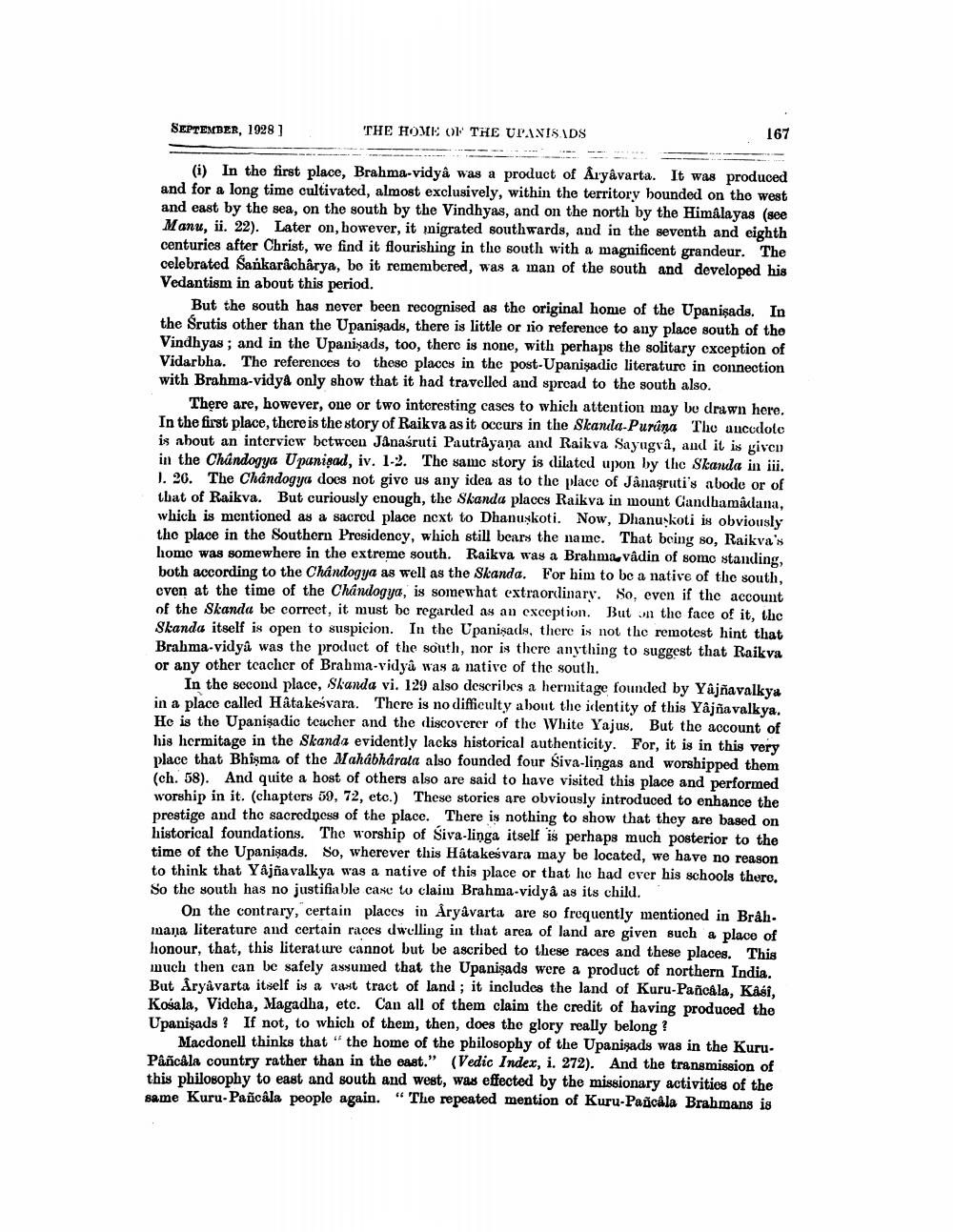________________
SEPTEMBER, 1928)
THE HOME OF THE ULANIS IDS
167
(i) In the first place, Brahma-vidyâ was a product of Aryavarta. It was produced and for a long time cultivated, almost exclusively, within the territory bounded on the west and east by the sea, on the south by the Vindhyas, and on the north by the Himalayas (see Manu, ii. 22). Later on, however, it migrated southwards, and in the seventh and eighth centuries after Christ, we find it flourishing in the south with a magnificent grandeur. The celebrated Sankaracharya, bo it remembered, was a man of the south and developed his Vedantism in about this period.
But the south has never been recognised as the original home of the Upanisads. In the Srutis other than the Upanisads, there is little or no reference to any place south of the Vindhyas; and in the Upanixads, too, there is none, with perhaps the solitary exception of Vidarbha. The references to these places in the post-Upanişadic literature in connection with Brahma-vidyå only show that it had travelled and spread to the south also.
There are, however, one or two interesting cases to which attention may be drawn here. In the first place, there is the story of Raikva as it occurs in the Skanila-Purúna Tho ancodote is about an interview between Janaśruti Pautrayana and Raikva Sayugra, and it is given in the Chandogya Upanisad, iv. 1-2. The same story is dilated upon by the Skanda in iii. 1. 26. The Chándogya does not give us any idea as to the place of Jânaşruti's abode or of that of Raikva. But curiously enough, the Skanda places Raikva in mount Candbamaulana, which is mentioned as a sacred place next to Dhanuškoti. Now, Dhanuskoti is obviously the place in the Southern Presidency, which still bears the name. That being so, Raikva's home was somewhere in the extreme south. Raikva was a Brahma vadin of some standing, both according to the Chándogya as well as the Skanda. For him to be a native of the south, cven at the time of the Chándogya, is somewhat extraordinary. So, even if the account of the Skanda be correct, it must be regarded as an exception. But on the face of it, the Skanda itself is open to suspicion. In the Upanisady, there is not the remotest hint that Brahma-vidya was the product of the south, nor is there anything to suggest that Raikva or any other teacher of Brahma-vidyâ was a native of the south.
In the second place, Skanda vi. 129 also describes a hermitage founded by Yajñavalkya in a place called Hâtakesvara. There is no difficulty about the identity of this Yajñavalkya. He is the Upanisadio teacher and the discoverer of the White Yajus. But the account of his hermitage in the Skanda evidently lacks historical authenticity. For, it is in this very place that Bhişma of the Mahabharata also founded four Siva-lingas and worshipped them (ch. 58). And quite a host of others also are said to have visited this place and performed worship in it. (chapters 59, 72, etc.) These stories are obviously introduced to enhance the prestige and the sacredness of the place. There is nothing to show that they are based on historical foundations. The worship of Siva-linga itself is perhaps much posterior to the time of the Upanişads. So, wherever this Hatakeśvara may be located, we have no reason to think that Yajnavalkya was a native of this place or that he had ever his schools there, So the south has no justifiable case to claim Brahma-vidyå as its child.
On the contrary," certain places in Aryavarta are so frequently mentioned in Brâh. mana literature and certain races dwelling in that area of land are given such a place of honour, that. this literature cannot but be ascribed to these races and these places. This much then can be safely assumed that the Upanişads were a product of northern India. But Aryavarta itself is a vast tract of land; it includes the land of Kuru-Pancala, Kaši, Kosala, Videha, Magadha, etc. Can all of them claim the credit of having produced the Upanişads? If not, to which of them, then, does the glory really belong?
Macdonell thinks that "the home of the philosophy of the Upanisads was in the Kuru. Pancala country rather than in the east." (Vedic Index, i. 272). And the transmission of this philosophy to east and south and west, was effected by the missionary activities of the game Kuru. Pancala people again. "The repeated mention of Kuru-Paxcala Brahmans is




